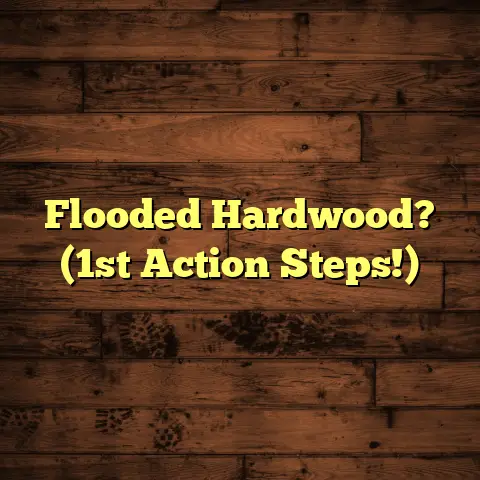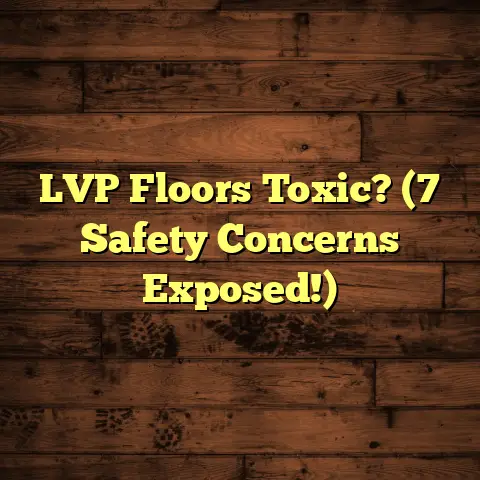Squeaky Floors in Winter? Read This! (4 Fixes!)
Ever feel like your house is talking back to you?
I mean, specifically through those annoying squeaks under your feet every time you take a step?
You’re not alone!
As a flooring contractor with over 15 years in the game, I can tell you that squeaky floors are one of the most common complaints I hear, especially during the winter months.
But here’s the game-changing idea: that annoying squeak isn’t just a minor irritation.
It can actually be a telltale sign of deeper issues within your home’s structure.
Think of it as your house whispering (or maybe yelling) that something needs attention.
Winter really cranks up the volume on these squeaks because of temperature changes and humidity swings.
Trust me, I’ve seen it all – from minor squeaks that drive people nuts to serious underlying problems that can impact your home’s safety and value.
So, let’s dive into the world of squeaky floors, understand why they happen, and, most importantly, figure out how to fix them!
Section 1: Understanding the Causes of
Squeaky Floors in Winter
Okay, so why are your floors suddenly singing (and not in a good way) when the temperature drops?
It all boils down to a few key factors, and understanding them is the first step to silencing those pesky squeaks.
The Temperature Tango
Wood, like any material, expands and contracts with temperature changes.
In the winter, when the temperature drops, the wood in your floors shrinks.
This contraction can create gaps between floorboards, subflooring, and even the nails or screws holding everything together.
These gaps allow for movement, and when you walk across them, you get that telltale squeak.
Think of it like this: imagine two pieces of wood that are tightly pressed together in the summer heat.
As it gets colder, they pull away from each other slightly, creating a tiny space.
Now, put some pressure on that space, and squeak!
The Moisture Mystery
Humidity plays a huge role too.
In the winter, we crank up the heat, which dries out the air inside our homes.
This dry air sucks moisture out of the wood, causing it to shrink even more.
According to the EPA, ideal indoor humidity should be between 30-50%. (Source: EPA)
When humidity drops below this, your floors can really start to suffer.
I’ve seen cases where floors that were perfectly silent in the summer become squeak factories in the winter simply due to dry air.
The Construction Connection
The way your home was built also has a big impact.
Older homes, in particular, often have floors that were installed using less sophisticated methods.
Nails might have loosened over time, or the subflooring might have warped or deteriorated.
Even in newer homes, poor installation can lead to squeaks.
For example, if the subfloor wasn’t properly secured to the joists, it can move and rub against the floorboards above, creating noise.
I’ve seen contractors cut corners on subfloor installation to save time and money.
Trust me, it always comes back to haunt them (and the homeowner) later!
Section 2: The Importance of Addressing
Squeaky Floors
“It’s just a squeak, right? What’s the big deal?”
That’s what a lot of homeowners think, but ignoring those squeaky floors can be a big mistake.
Here’s why you should take them seriously:
Safety First
Unchecked floor movement can lead to some serious safety hazards.
Loose floorboards can become tripping hazards, especially for older adults or young children.
In extreme cases, significant structural damage can occur if the underlying supports are compromised.
I once inspected a home where a persistent squeak turned out to be a sign of a rotting subfloor.
The homeowner was lucky they caught it before someone fell through!
Home Value Hit
Think about it from a buyer’s perspective: you’re walking through a house you’re considering buying, and every step you take is accompanied by an ear-splitting squeak.
Not exactly a confidence booster, right?
Squeaky floors can definitely deter potential buyers and even lower your home’s resale value.
According to a 2023 survey by the National Association of Realtors, 78% of buyers said that the condition of the floors was an important factor in their decision-making process. (Source: NAR)
I’ve seen deals fall through because of something as seemingly minor as squeaky floors.
Opportunity Knocks
Instead of viewing squeaky floors as a nuisance, see them as an opportunity for necessary home maintenance.
Addressing these issues early can prevent more serious (and expensive) problems down the road.
Think of it as a chance to give your home some TLC and ensure it stays in tip-top shape for years to come.
Section 3: Four Effective Fixes for
Squeaky Floors
Alright, let’s get down to business!
Here are four effective ways to silence those squeaky floors and restore peace and quiet to your home:
Fix 1: Applying Lubricants
This is often the easiest and quickest fix, and it works well for minor squeaks caused by friction between floorboards.
The idea is to reduce the rubbing that creates the noise.
Here are a few lubricants you can try:
- Powdered Graphite: This is a classic choice for a reason. It’s a dry lubricant that won’t damage your floors, and it’s great for getting into tight spaces.
- Talcum Powder: Similar to graphite, talcum powder can help reduce friction. Just be careful not to use too much, as it can get messy.
- Silicone Spray: This is a good option for floors that are prone to moisture. Just make sure to choose a silicone spray that’s specifically designed for use on wood floors.
Step-by-Step Guide:
- Identify the Squeak: Walk around the room and pinpoint the exact location of the squeak.
- Apply the Lubricant: For powdered lubricants, use a small squeeze bottle or a powder duster to apply the lubricant directly into the gaps between the floorboards. For silicone spray, use the nozzle to target the squeaky area.
- Work it In: Walk across the area several times to work the lubricant into the gaps.
- Wipe Away Excess: Use a damp cloth to wipe away any excess lubricant from the surface of the floor.
Pro Tip: If you’re using powdered graphite, be careful not to get it on your clothes or furniture, as it can stain.
Fix 2: Securing Loose Floorboards
If the squeak is caused by a loose floorboard rubbing against the subfloor or another floorboard, you’ll need to secure it.
Here’s how:
- Identify the Loose Board: Again, pinpoint the exact location of the squeak. You might be able to feel the board move slightly when you step on it.
- Choose Your Fastener: For most situations, screws are a better option than nails because they provide a stronger hold. Use flooring screws that are designed to grip wood tightly.
- Pre-Drill a Pilot Hole: This is crucial to prevent the wood from splitting. Use a drill bit that’s slightly smaller than the diameter of the screw.
- Drive in the Screw: Drive the screw in at an angle, so it goes through the floorboard and into the subfloor. Be careful not to overtighten the screw, as this can strip the wood.
- Countersink the Screw Head: Use a countersink bit to create a small recess for the screw head. This will prevent the screw head from sticking up above the surface of the floor.
- Fill the Hole (Optional): If you want to hide the screw head, you can fill the hole with wood filler that matches the color of your floor.
Pro Tip: If you’re working with hardwood floors, use a screw that’s specifically designed for hardwood.
These screws have a special thread pattern that helps them grip the wood without splitting it.
Fix 3: Installing Squeak-Repair Kits
These kits are designed to provide a quick and easy fix for squeaky floors, especially when the squeak is coming from below the floor.
Here’s what you can expect to find in a typical squeak-repair kit:
- Screws: These are specially designed screws that are meant to be driven through the carpet (if applicable) and into the subfloor.
- Alignment Tool: This tool helps you align the screw properly so it goes straight into the subfloor.
- Break-Away Screw Heads: These screws have heads that are designed to break off cleanly once they’re fully installed.
Installation Guide:
- Locate the Squeak: Use the kit’s locator tool to find the exact location of the squeak.
- Insert the Screw: Insert the screw into the alignment tool and drive it through the carpet (if applicable) and into the subfloor.
- Break Off the Screw Head: Once the screw is fully installed, use the tool to break off the screw head.
Pro Tip: Squeak-repair kits are best suited for floors that are covered with carpet.
If you have hardwood floors, you’ll want to use a different method.
Fix 4: Consulting a Professional
Sometimes, the squeak is a sign of a more serious problem that requires the expertise of a professional.
Here are some scenarios where it’s best to call in the pros:
- Extensive Squeaking: If the squeaking is widespread and you’re not able to pinpoint the exact source, it’s probably a sign of a larger problem.
- Structural Damage: If you suspect that the squeaking is caused by structural damage, such as a rotting subfloor or damaged joists, it’s important to call a professional right away.
- You’re Not Comfortable Doing the Work Yourself: If you’re not comfortable working with tools or you’re not sure how to properly secure the floorboards, it’s always best to err on the side of caution and call a professional.
Checklist for Choosing a Professional:
- Experience: Look for a contractor who has experience working with floors and who is familiar with the types of flooring you have in your home.
- References: Ask for references from past clients and check online reviews.
- Insurance: Make sure the contractor is properly insured.
- License: Verify that the contractor has a valid license to operate in your area.
- Estimate: Get a written estimate that outlines the scope of the work and the cost of the materials and labor.
Pro Tip: Don’t be afraid to get multiple estimates from different contractors.
This will give you a better sense of the going rate for the work and help you find the best value.
Conclusion: Empowering Homeowners to
Take Action
So, there you have it!
Squeaky floors in winter are a common problem, but they’re not something you have to live with.
With the right knowledge and tools, you can effectively manage those pesky squeaks and enjoy a quieter, more comfortable living space.
Remember, addressing squeaky floors isn’t just about silencing an annoying noise.
It’s about protecting your home’s value, ensuring your family’s safety, and taking pride in your living space.
So, take action this winter and transform that bothersome issue into a chance for home improvement.
You got this!





